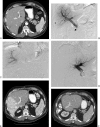Portal vein embolization: rationale, technique, and current application
- PMID: 23729977
- PMCID: PMC3444878
- DOI: 10.1055/s-0032-1312568
Portal vein embolization: rationale, technique, and current application
Abstract
Portal vein embolization (PVE) is a technique used before hepatic resection to increase the size of liver segments that will remain after surgery. This therapy redirects portal blood to segments of the future liver remnant (FLR), resulting in hypertrophy. PVE is indicated when the FLR is either too small to support essential function or marginal in size and associated with a complicated postoperative course. When appropriately applied, PVE has been shown to reduce postoperative morbidity and increase the number of patients eligible for curative intent resection. PVE is also being combined with other therapies in novel ways to improve surgical outcomes. This article reviews the rationale, technical considerations, and current use of preoperative PVE.
Keywords: Portal vein; embolization; liver malignancy; liver resection.
Figures



References
-
- Jemal A, Siegel R, Xu J, Ward E. Cancer statistics, 2010. CA Cancer J Clin. 2010;60(5):277–300. - PubMed
-
- Bosch F X, Ribes J, Díaz M, Cléries R. Primary liver cancer: worldwide incidence and trends. Gastroenterology. 2004;127(5, Suppl 1):S5–S16. - PubMed
-
- Shoup M, Gonen M, D'Angelica M, Jamagin W R, DeMatteo R P, Schwartz L H. et al.Volumetric analysis predicts hepatic dysfunction in patients undergoing major liver resection. J Gastrointest Surg. 2003;7(3):325–330. - PubMed
-
- Ribero D, Abdalla E K, Madoff D C, Donadon M, Loyer E M, Vauthey J N. Portal vein embolization before major hepatectomy and its effects on regeneration, resectability and outcome. Br J Surg. 2007;94(11):1386–1394. - PubMed

